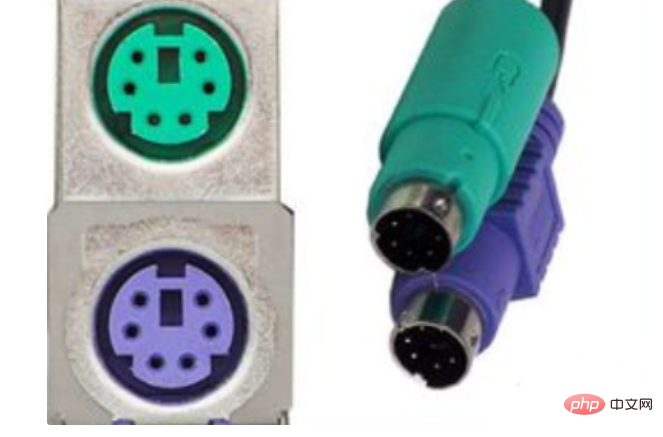What types of keyboard interfaces are there?
There are three types of keyboard interfaces: 1. "PS/2" interface, which is a special interface for mouse and keyboard. It is a six-pin circular interface. The keyboard only uses 4 pins to transmit data and power supply; 2. USB interface, which has become the most important interface method for various devices; 3. MIDI interface, which is a kind of hardware that connects computers and MIDI devices.

The operating environment of this tutorial: Windows 10 system, DELL G3 computer.
What are the types of keyboard interfaces?
The keyboard interface type refers to the interface method or type between the keyboard and the computer host.
Different keyboards have different interfaces. If you understand the interfaces of the keyboard, you will not find that the keyboard you bought cannot be used. Among them, the PS/2 interface can be said to be the mouse interface equipped on every motherboard. It is the most versatile. Sometimes we also call it "round mouth"; the counterpart of "round mouth" is "big mouth", which has many Found on some old-fashioned motherboards, that is, the AT interface method (rarely seen anymore). The USB interface is a product that appeared later than the first two, and the USB interface of the motherboard can not only be used to connect the mouse, but also other USB devices, and the transmission speed is higher, which also saves the PS/2 port of the motherboard. . Motherboards generally have two interfaces, PS/2 and USB.
PS/2 interface
first appeared on IBM's PS/2 machine, hence the name. This is a dedicated interface for mouse and keyboard. It is a 6-pin circular interface, but the keyboard only uses 4 of the pins to transmit data and power, and the remaining 2 are empty pins. The transmission rate of the PS/2 interface is slightly faster than that of the COM interface, and it is the standard interface of the ATX motherboard. It is one of the most widely used keyboard interfaces.

Both the keyboard and mouse can use the PS/2 interface, but according to the PC'99 color specification, the mouse usually occupies the light green interface and the keyboard occupies the purple interface. Although the working principles of the two interfaces are the same from the above pin definitions, the two interfaces cannot be mixed. This is determined by their different signal definitions inside the computer.
USB interface
The full name of USB is Universal Serial Bus. USB supports hot-swap and plug-and-play advantages, so the USB interface has become the preferred choice for many devices. The most important interface method. USB has three specifications, namely USB1.1 and USB2.0 and the emerging USB3.0.
There is not much difference in use between keyboards with PS/2 interface and USB interface. Since the USB interface supports hot swapping, USB interface keyboard may be slightly more convenient to use. However, the underlying computer hardware supports the PS/2 interface more fully, so if the computer encounters certain failures, the keyboard using the PS/2 interface will have better compatibility. Mainstream keyboards use either PS/2 interface or USB interface. You need to choose according to your needs when purchasing. Various keyboard interfaces can also be converted through specific adapters or cables, such as USB to PS/2 adapters.
MIDI interface; MIDI interface is a kind of hardware that connects computers and MIDI devices. It is also a standard for digital music.
The keyboard interface type refers to the interface method or type between the keyboard and the computer host. There are two common keyboard interfaces on the market: PS/2 interface and USB interface. There is also an old-fashioned AT interface that is no longer common, commonly known as "big mouth". It has been basically eliminated, so it will not be introduced.
The difference between keyboard interface ps2 and usb types
To put it simply: a data packet of the USB keyboard has only 8 bytes (why only 8, this is because the protocol stipulates, why the protocol stipulates this, because in the early days, the USB speed was slow, and the maximum number of packets transmitted using interrupts was 8 bytes), of which 2 bytes mark the status, and the remaining 6 bytes are used To record the scan code of the currently pressed or popped-up key, therefore, the USB keyboard can describe the status of up to 6 keys at the same time.
This deceptive design specification of the USB keyboard results in that it can only achieve up to 6 keys without rollover. To solve this problem, the USB keyboard specifications must be redesigned, but I guess no one is willing to do this, because this thing works well, and most people will not press 6 keys at the same time.
As for the PS/2 keyboard, this specification is not used. PS/2 is: report whatever is pressed, and report whatever is popped up. If 10 keys are pressed at the same time, 10 will be reported in sequence. There is no protocol limit on how many key press events can be recorded at the same time. It depends on the operating system itself. Therefore, the PS/2 keyboard can theoretically achieve unlimited key presses without rollover.
Of course, some people have indeed seen USB keyboards break the 6-key limit. One of the possible reasons is: the USB device built into this keyboard is a multiple keyboard USB HUB, because USB allows multi-level Device connection, so you can break the 6 limit.
Of course, it is also a solution to bring the USB keyboard with its own driver, because although the interrupt transmission only has 6 bytes, the Bulk transmission can transmit 256 bytes without any problem. (Note: I searched on Baidu myself and found that although many manufacturers have implemented USB full-key rollover, there seem to be a lot of bugs. It seems that the technology still needs to be developed.) In short, the specifications are the specifications, and there are always those that are not restricted by the specifications. Method.
For more related knowledge, please visit the FAQ column!
The above is the detailed content of What types of keyboard interfaces are there?. For more information, please follow other related articles on the PHP Chinese website!

Hot AI Tools

Undresser.AI Undress
AI-powered app for creating realistic nude photos

AI Clothes Remover
Online AI tool for removing clothes from photos.

Undress AI Tool
Undress images for free

Clothoff.io
AI clothes remover

AI Hentai Generator
Generate AI Hentai for free.

Hot Article

Hot Tools

Notepad++7.3.1
Easy-to-use and free code editor

SublimeText3 Chinese version
Chinese version, very easy to use

Zend Studio 13.0.1
Powerful PHP integrated development environment

Dreamweaver CS6
Visual web development tools

SublimeText3 Mac version
God-level code editing software (SublimeText3)

Hot Topics
 1375
1375
 52
52
 In-depth search deepseek official website entrance
Mar 12, 2025 pm 01:33 PM
In-depth search deepseek official website entrance
Mar 12, 2025 pm 01:33 PM
At the beginning of 2025, domestic AI "deepseek" made a stunning debut! This free and open source AI model has a performance comparable to the official version of OpenAI's o1, and has been fully launched on the web side, APP and API, supporting multi-terminal use of iOS, Android and web versions. In-depth search of deepseek official website and usage guide: official website address: https://www.deepseek.com/Using steps for web version: Click the link above to enter deepseek official website. Click the "Start Conversation" button on the homepage. For the first use, you need to log in with your mobile phone verification code. After logging in, you can enter the dialogue interface. deepseek is powerful, can write code, read file, and create code
 deepseek web version official entrance
Mar 12, 2025 pm 01:42 PM
deepseek web version official entrance
Mar 12, 2025 pm 01:42 PM
The domestic AI dark horse DeepSeek has risen strongly, shocking the global AI industry! This Chinese artificial intelligence company, which has only been established for a year and a half, has won wide praise from global users for its free and open source mockups, DeepSeek-V3 and DeepSeek-R1. DeepSeek-R1 is now fully launched, with performance comparable to the official version of OpenAIo1! You can experience its powerful functions on the web page, APP and API interface. Download method: Supports iOS and Android systems, users can download it through the app store; the web version has also been officially opened! DeepSeek web version official entrance: ht
 How to solve the problem of busy servers for deepseek
Mar 12, 2025 pm 01:39 PM
How to solve the problem of busy servers for deepseek
Mar 12, 2025 pm 01:39 PM
DeepSeek: How to deal with the popular AI that is congested with servers? As a hot AI in 2025, DeepSeek is free and open source and has a performance comparable to the official version of OpenAIo1, which shows its popularity. However, high concurrency also brings the problem of server busyness. This article will analyze the reasons and provide coping strategies. DeepSeek web version entrance: https://www.deepseek.com/DeepSeek server busy reason: High concurrent access: DeepSeek's free and powerful features attract a large number of users to use at the same time, resulting in excessive server load. Cyber Attack: It is reported that DeepSeek has an impact on the US financial industry.



